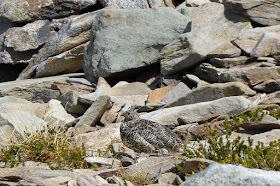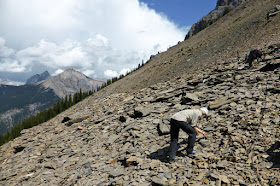After parking at the airport we turned over our keys to the staff, in case the autos in the fenced lot needed to be reshuffled while we were away. We and our baggage were weighed. There is a theoretical weight limit of baggage per passenger, but in practice, if the whole load doesn't breach the helicopter's capacity Alpine Helicopters doesn't bother to weigh individual bags. Joan and I spent time the night before reorganizing our luggage to meet the requirement anyway, and we left unnecessary stuff in the car trunk.
Bear spray must be separate and must travel in the external luggage box.
It would take three round trips to ferry all the guests, staff, and supplies to the lodge.
 |
| About a 15 minute flight. |
The route took us over the Kicking Horse Resort, just outside Golden.
The chopper was climbing steadily to get over the first mountain range.
 |
| Higher ... higher ... |
The pad at Purcell Mountain Lodge requires a precise landing at 2200 meters, or 7200 feet.
Snacks and lunch fixings were available, and our first guided hike began at 11:00. There were plenty of trails around the lodge,
and our guides Sarah and Kristin started us heading north and west through the meadowland, where we encountered both flowers and hummingbirds. (Given that our cook was Grace and the lodge manager Cherise, it was an all-female staff for this rotation.) The Selkirk mountains dominated the western horizon.
 |
| The tallest one, towards the right, is Mount Sir Donald |
A closeup of those mountains.
The brown smudge on the right side of Sir Donald (the tallest peak) and the glacier beneath was a major rockfall from just one week ago, reported to Parks Canada by Sarah.
Our group turned to the south. Looking to my left, I took this photo of the main lodge (right) and auxiliary building.
This photo zooms in on a section of the Selkirks with a tongue of the Illecillewaet Glacier (top) and a waterfall (bottom.)
Our guides then took us down the west side of the meadowlands towards the "Kneegrinder." Sarah acquainted us with the term "lava tree," implying its function, "lavatory."
We stopped on top of the Grinder for our lunch break.
Afterwards our group continued on, skirting the National Park boundary.
We soon encountered a ptarmigan.
And one of its youngsters.
This panorama encompasses most of our hike. The bright spot in the center is the lodge roof.
We returned to the lodge to settle into our rooms and clean up. At Purcell each room has its own vanity and sink, and across the hall are three private shower rooms and three private water closets, with the lights on timers that the user sets. For a back country lodge this was very posh.
At the beginning of August sunset is still very late.
Tomorrow Sarah and Kristin will take us, huffing and puffing, to the top of Copperstain Mountain.
The brown smudge on the right side of Sir Donald (the tallest peak) and the glacier beneath was a major rockfall from just one week ago, reported to Parks Canada by Sarah.
Our group turned to the south. Looking to my left, I took this photo of the main lodge (right) and auxiliary building.
This photo zooms in on a section of the Selkirks with a tongue of the Illecillewaet Glacier (top) and a waterfall (bottom.)
Our guides then took us down the west side of the meadowlands towards the "Kneegrinder." Sarah acquainted us with the term "lava tree," implying its function, "lavatory."
We stopped on top of the Grinder for our lunch break.
Afterwards our group continued on, skirting the National Park boundary.
We soon encountered a ptarmigan.
And one of its youngsters.
 |
| Still sporting some down. |
 |
| The bright streaks are created by the camera's stitching function. |
At the beginning of August sunset is still very late.
Tomorrow Sarah and Kristin will take us, huffing and puffing, to the top of Copperstain Mountain.






































